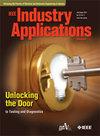A Fast Neural Network-Based Battery SOH Estimation Using Load Surge Response Characteristics
IF 4.2
2区 工程技术
Q2 ENGINEERING, ELECTRICAL & ELECTRONIC
引用次数: 0
Abstract
Monitoring the performance of lithium-ion batteries is crucial for the manufacture and operation of various industrial applications. The state of health shows the health status of the batteries. This paper proposes a novel method for fast estimation of battery state of health by leveraging response characteristics during load surges and optimizing the process through a genetic algorithm-extreme learning machine model. Traditional estimation techniques often rely on complete charge/discharge profiles, which are inefficient for online monitoring and real-time applications. The proposed method extracts key features from voltage response curves during inrush currents, thereby eliminating the need for full charge/discharge data. Techniques such as discrete wavelet transform and differential voltage analysis are employed to capture vital health indicators. The genetic algorithm-extreme learning machine algorithm significantly reduces computational complexity while ensuring high estimation accuracy by optimizing the parameters of the extreme learning machine. Experimental results demonstrate that the model achieves high accuracy (within 3%) in estimating state of health across various states of charge. This method is particularly suitable for applications requiring rapid and non-invasive battery health assessments, such as backup power systems and electric vehicle startups.基于负载浪涌响应特性的快速神经网络电池SOH估计
监测锂离子电池的性能对于各种工业应用的制造和运行至关重要。“健康状态”显示电池的健康状态。本文提出了一种利用负载波动时的响应特性,并通过遗传算法-极限学习机模型对过程进行优化的快速估计电池健康状态的新方法。传统的估算技术通常依赖于完整的充电/放电曲线,这对于在线监测和实时应用来说是低效的。该方法从浪涌电流期间的电压响应曲线中提取关键特征,从而消除了对完整充电/放电数据的需要。采用离散小波变换和差分电压分析等技术捕捉重要的健康指标。遗传算法-极限学习机算法通过优化极限学习机的参数,在保证较高估计精度的同时,显著降低了计算复杂度。实验结果表明,该模型在估计不同充电状态下的健康状态方面达到了较高的精度(在3%以内)。这种方法特别适用于需要快速和非侵入性电池健康评估的应用,例如备用电源系统和电动汽车启动。
本文章由计算机程序翻译,如有差异,请以英文原文为准。
求助全文
约1分钟内获得全文
求助全文
来源期刊

IEEE Transactions on Industry Applications
工程技术-工程:电子与电气
CiteScore
9.90
自引率
9.10%
发文量
747
审稿时长
3.3 months
期刊介绍:
The scope of the IEEE Transactions on Industry Applications includes all scope items of the IEEE Industry Applications Society, that is, the advancement of the theory and practice of electrical and electronic engineering in the development, design, manufacture, and application of electrical systems, apparatus, devices, and controls to the processes and equipment of industry and commerce; the promotion of safe, reliable, and economic installations; industry leadership in energy conservation and environmental, health, and safety issues; the creation of voluntary engineering standards and recommended practices; and the professional development of its membership.
 求助内容:
求助内容: 应助结果提醒方式:
应助结果提醒方式:


